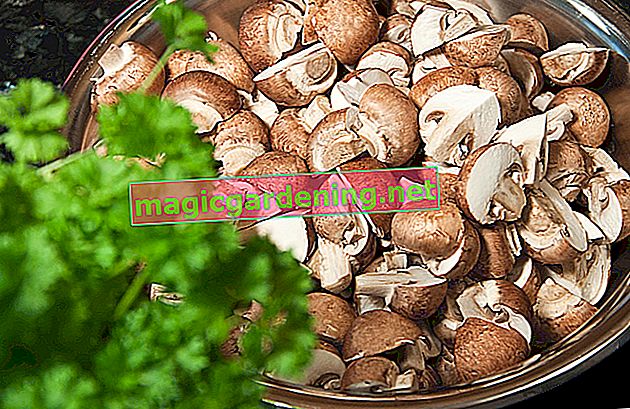
Before cleaning: Check the mushrooms for freshness
Basically, you should only use fresh mushrooms, not just for aesthetic or taste reasons. You can recognize fresh specimens by the closed or only slightly open slats on the bottom of the hat - the further they have already opened, the more time has passed since the harvest. Old mushrooms also tend to go moldy quickly. If this is the case and you can see fine, white threads of mold on the mushrooms, you should not eat them anymore. Instead, they should be thrown away in the household waste to avoid fungal poisoning. On the other hand, some slightly brownish discolored bruises on the mushroom cap are harmless: mushrooms are very sensitive to pressure. Simply cut away these spots with a sharp paring knife.
also read
- Cut and clean mushrooms properly
- Freezing fresh mushrooms - this is how it's done
- The season of mushrooms
When should you peel mushrooms?
Older people in particular have learned that mushrooms are peeled. Maybe your mother or grandmother pulled the delicate skin off the mushrooms. Of course, this method is perfect for quickly cleaning the mushrooms - but at the same time you remove valuable vitamins that are in the skin of the mushrooms. You should therefore only peel or peel mushrooms if they are really very dirty and cannot be cleaned otherwise.
Do not wash the mushrooms
If the mushrooms are covered with soil, one is quickly inclined to wash them thoroughly in clear water. This is not a good idea, however, because mushrooms soak up the wash water like a sponge. Although this water is lost again during frying, the mushrooms retain a spongy, rubbery consistency. They also lose a lot of their aroma. The same applies to mushrooms that are to be eaten raw in salads etc. You can only clean the mushrooms individually under running, clear water if they are very dirty. But then rub them dry well with a dry kitchen towel.
How to clean mushrooms properly - Here's how to do it
If you are not allowed to wash or peel mushrooms, how else can you remove any adhering soil or substrate without leaving any residue? There is a tried and tested method for this, for which you need a thick, soft bristle brush and paper kitchen towels.
Roughly clean the mushrooms with a brush
First of all, gently remove coarse soiling with the soft brush, previously cleaned and dried in clear water. Use it like a hand brush - simply "sweep" away any clinging earth and other dirt. You can use normal round brushes, but there are also real mushroom or mushroom brushes available in stores.
Carry out fine cleaning with a kitchen towel
Once the coarse dirt has been removed, take a clean paper towel and gently rub each individual mushroom thoroughly clean. Be careful not to grip the mushrooms too tightly - like all mushrooms, too much pressure quickly turns them brown, unsightly.
Cut away pressure points with a knife
Finally, cut away the existing pressure points and the dried-on end of the stem and then process the mushrooms as desired. A sharp paring knife is best for this.
Tips
Brown mushrooms (also known as “stone mushrooms”) are cleaned and prepared in the same way as white ones - you don't need to follow any special tips or hints here.








